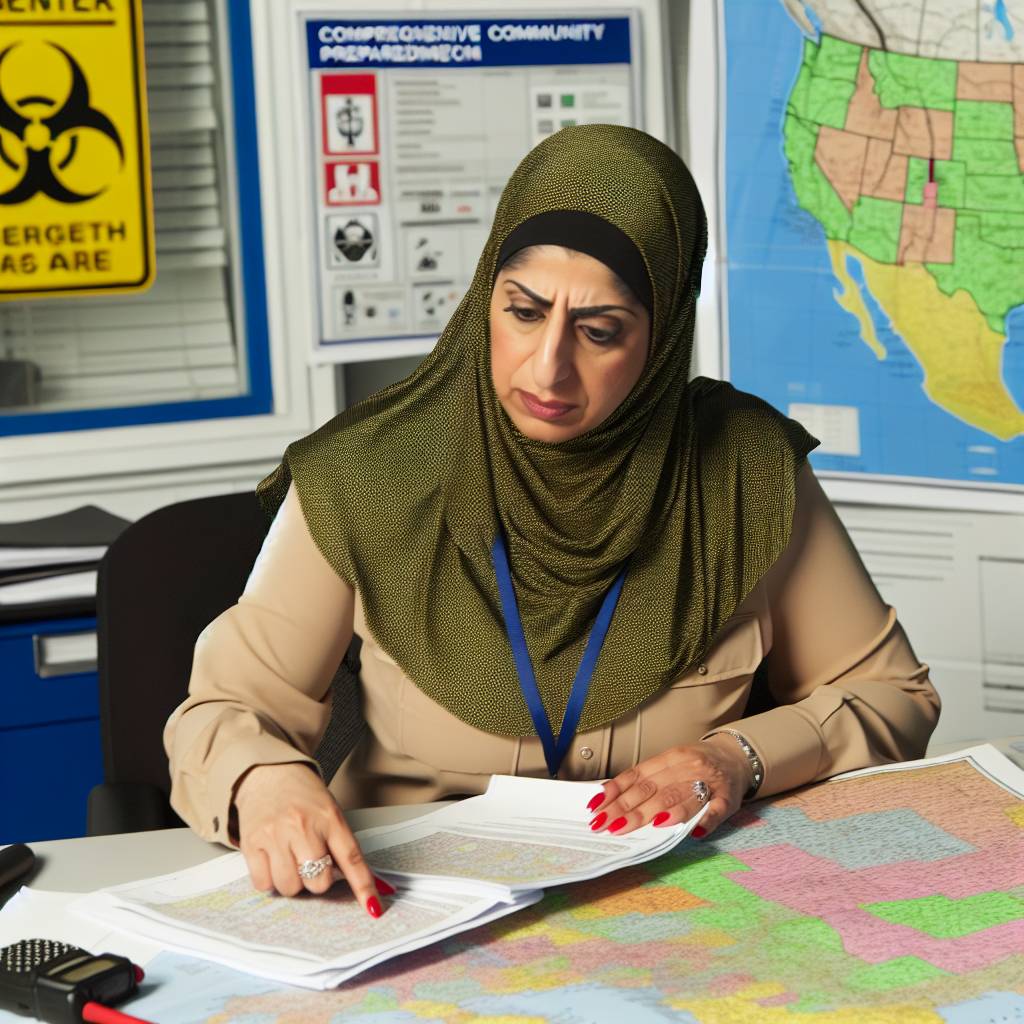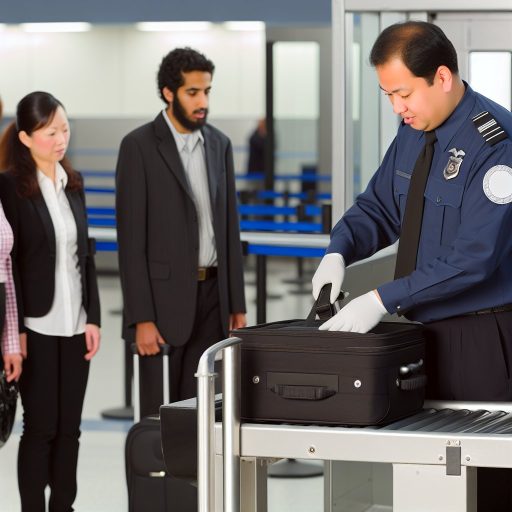Introduction:
As an Emergency Management Director, their role is crucial in disaster preparedness and response.
Community preparedness programs play a vital role in reducing the impact of emergencies.
The Director oversees the implementation and management of these programs to ensure effectiveness.
It is imperative for the community to be well-prepared for any potential disaster to minimize risks and ensure swift recovery.
The Director’s responsibilities include developing emergency plans, coordinating training exercises, and collaborating with local agencies.
By engaging with the community, the Director can enhance awareness and readiness, ultimately saving lives and minimizing damage.
Community involvement is key in building a resilient society that can withstand and recover from various emergencies.
Effective communication and coordination are essential for successful community preparedness programs.
Continuous evaluation and improvement of emergency plans are necessary to adapt to evolving threats and vulnerabilities.
Overall, the role of an Emergency Management Director in community preparedness is instrumental in ensuring the safety and well-being of the population.
Importance of Community Preparedness Programs:
Having a well-prepared community reduces casualties and damage during emergencies.
Community preparedness programs improve the overall resilience of a community.
Successful community preparedness programs have a significant impact on disaster response.
Benefits of Having a Well-Prepared Community:
- Rapid response and timely evacuation save lives and minimize injuries.
- Effective communication systems ensure coordination among residents and emergency personnel.
- Training programs teach essential skills like first aid, CPR, and fire safety.
- Community drills and exercises enhance preparedness and familiarize residents with emergency procedures.
- Collaboration with local authorities increases the effectiveness of emergency response efforts.
How Community Preparedness Programs Improve Community Resilience:
- Empowerment of residents leads to a proactive approach in preparing for emergencies.
- Education on risks and hazards enables informed decision-making during crisis situations.
- Building strong social networks fosters mutual assistance and support within the community.
- Access to resources and tools ensures the ability to withstand and recover from disasters.
Examples of Successful Community Preparedness Programs:
- The Community Emergency Response Team (CERT) trains volunteers to assist first responders.
- Neighborhood Watch programs enhance security and promote community cohesion.
- School-based emergency preparedness initiatives educate students, staff, and families on safety measures.
- Community-wide emergency drills like earthquake simulations improve readiness and response coordination.
- Public awareness campaigns raise knowledge about disaster risks and preparedness measures.
Role of an Emergency Management Director:
Responsible for planning and executing community preparedness programs.
Develop emergency response plans and coordinate drills to test preparedness.
Communicate with local officials, emergency services, and the public.
Collaboration with Local Government Agencies:
Coordinate efforts with fire, police, and other local agencies.
Work with non-profit organizations to provide resources and support.
Partner with community groups to engage and educate residents.
Importance of Collaboration:
Pooling resources and expertise for more effective programs.
Transform Your Career Today
Unlock a personalized career strategy that drives real results. Get tailored advice and a roadmap designed just for you.
Start NowEnhancing communication and coordination during emergencies.
Building relationships and trust within the community.
Challenges Faced by Emergency Management Directors:
Limited funding for preparedness initiatives and training.
Balancing competing priorities and demands on resources.
Overcoming public apathy or complacency towards disaster preparedness.
Find Out More: Cybersecurity Specialist: Ethical Considerations in the Job
Components of Community Preparedness Programs:
- Identify the key elements: risk assessment, emergency planning, training, and outreach.
- Explain the vital role each component plays in enhancing community resilience and response capabilities.
- Provide examples of successful community preparedness programs that have effectively incorporated these components.
Risk Assessment:
Risk assessment is a crucial component of a community preparedness program.
It involves identifying potential hazards, vulnerabilities, and the likelihood of disasters occurring in a specific area.
By conducting a thorough risk assessment, emergency management directors can better understand the risks faced by their communities and develop proactive measures to mitigate them.
Emergency Planning:
Emergency planning is another essential element of a comprehensive community preparedness program.
It involves creating detailed protocols and procedures for responding to various types of emergencies, such as natural disasters, hazardous material incidents, and public health emergencies.
Effective emergency planning ensures that all stakeholders know their roles and responsibilities during an emergency and can coordinate their efforts to minimize the impact on the community.
Training:
Training is critical for ensuring that community members are prepared to respond effectively to emergencies.
This includes providing training on first aid, CPR, disaster response, and other relevant skills.
By equipping individuals with the knowledge and skills they need to stay safe and help others during a crisis, training enhances overall community resilience and response capabilities.
Outreach:
Outreach efforts are essential for engaging community members and stakeholders in preparedness activities.
This includes disseminating information about potential risks, promoting emergency preparedness events, and encouraging participation in training exercises.
Effective outreach can help raise awareness about the importance of preparedness and motivate individuals to take proactive steps to protect themselves and their families.
Examples of Successful Community Preparedness Programs:
- The Community Emergency Response Team (CERT) program is a successful example of a community preparedness program that incorporates all key components. CERT trains volunteers in basic disaster response skills and organizes regular exercises and drills to practice emergency procedures.
- The Ready Campaign, launched by the Federal Emergency Management Agency (FEMA), is another successful initiative that focuses on outreach and public education. The campaign provides resources and tools to help individuals and communities prepare for emergencies and promotes a culture of preparedness.
- The Neighborhood Preparedness Program in Portland, Oregon, is a community-based program that emphasizes collaboration and communication among residents, businesses, and local organizations. The program has effectively engaged community members in preparing for emergencies and building resilience.
Find Out More: CBP Officer’s Role in Natural Disaster Response
Showcase Your Business Today
Reach thousands of readers actively exploring professional services. Publish your business profile and grow your audience now.
Publish NowBest Practices for Community Engagement:
Discuss strategies for engaging community members in preparedness efforts through education campaigns.
Organize workshops to teach essential skills like first aid, CPR, and emergency response protocols.
Conduct drills to simulate emergency scenarios and test community members’ ability to respond effectively.
Building Partnerships with Local Stakeholders:
- Collaborate with local government agencies, schools, businesses, and non-profit organizations.
- Establish relationships with community leaders, faith-based organizations, and neighborhood associations.
- Work with healthcare providers, emergency services, and volunteer groups to enhance community resilience.
Fostering a Culture of Preparedness:
- Encourage community members to create emergency plans for their families and households.
- Promote the importance of having emergency supply kits stocked with essential items.
- Provide training on how to recognize warning signs of emergencies and when to seek help.
You Might Also Like: How to Pass the DEA Agent Written Exam

Evaluation and Improvement of Community Preparedness Programs:
Conducting regular evaluations of community preparedness programs is crucial to assess their effectiveness.
Gathering feedback from community members and stakeholders helps identify areas for improvement.
Recommendations for enhancing programs should be based on evaluation findings and lessons learned.
Importance of Regular Evaluations:
Regular evaluations of community preparedness programs are essential to ensure they are meeting the needs of the community and are effective in preparing for emergencies.
Evaluations help identify strengths, weaknesses, and areas for improvement, allowing for adjustments to be made to enhance overall preparedness.
Methods for Collecting Feedback:
There are various methods for collecting feedback from community members and stakeholders to assess the effectiveness of preparedness programs.
Surveys, focus groups, interviews, and community forums are common ways to gather input from those directly impacted by the programs.
By engaging with the community and stakeholders, valuable insights can be gained on what is working well and where improvements can be made.
Recommendations for Adapting and Enhancing Programs:
Based on evaluation findings and lessons learned, it is important to adapt and enhance community preparedness programs to better meet the needs of the community.
Recommendations may include updating emergency plans, increasing training and education efforts, improving communication strategies, and collaborating with other organizations to strengthen overall readiness.
By continuously evaluating and refining programs, communities can be better prepared for emergencies and disasters.
Find Out More: Role of Deputy Sheriffs in Rural Areas
Case Studies:
- Present case studies of communities that have successfully implemented community preparedness programs, highlighting their strategies and outcomes.
- Discuss the role of Emergency Management Directors in guiding these communities through the process of developing and implementing preparedness initiatives.
- Outline key takeaways and lessons learned from these case studies that can be applied to other communities seeking to enhance their preparedness efforts.
In a small town in Pennsylvania, the Emergency Management Director worked with local schools, businesses, and community organizations to create a comprehensive preparedness program. They conducted emergency drills, distributed emergency kits, and provided training on first aid and CPR. As a result, the community was able to effectively respond to a severe storm that hit the area, minimizing injuries and property damage.
Emergency Management Directors play a crucial role in guiding communities through the process of developing and implementing preparedness initiatives. They work closely with local stakeholders to assess risks, develop response plans, and coordinate training and exercises. They also act as liaisons with state and federal agencies to ensure that communities have the resources they need to respond to emergencies effectively.
Key takeaways from these case studies include the importance of collaboration among community partners, the need for ongoing training and drills, and the value of clear communication during emergencies. Communities looking to enhance their preparedness efforts should focus on building strong relationships with local stakeholders, conducting regular exercises to test their plans, and providing clear and consistent information to residents.
Community Preparedness Programs Enhance Safety
Community preparedness programs are crucial in mitigating the impacts of emergencies.
Emergency Management Directors play a vital role in implementing these initiatives.
By being proactive and investing in preparedness measures, communities can significantly reduce the loss of lives and property during disasters.
I encourage all readers to explore and learn more about community preparedness programs.
Getting involved in these efforts can make our communities safer and more resilient in the face of emergencies.
Additional Resources
School Emergency Planning & Safety | California Governor’s Office …
Ventura County Fire Department – Committed to Excellence …
[E-Books for Sale]
The Big Book of 500 High-Paying Jobs in America: Unlock Your Earning Potential
$19.99 • 500 High-Paying Jobs • 330 pages
Explore 500 high-paying jobs in America and learn how to boost your career, earn more, and achieve success!
See All 500 High-Paying Jobs of this E-Book
1001 Professions Without a Degree: High-Paying American Jobs You Can Start Now
$19.99 • 1001 Professions Without a Degree • 174 pages
Discover 1001 high-paying jobs without a degree! Unlock career tips, skills, and success strategies for just $19.99!




